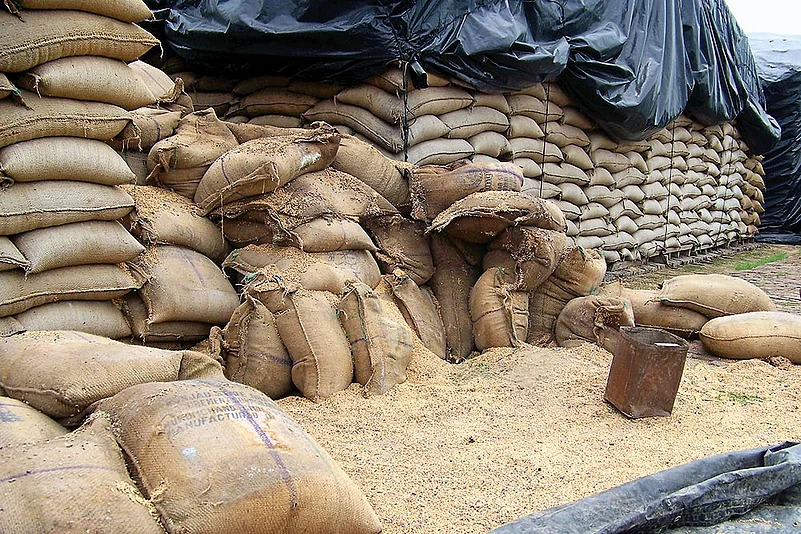The country is one of the world’s largest food producers but around 194 million Indians go hungry every day because we waste thousands of tonnes of grain every year. Successive governments had promised and initiated policies to stop the wastage—mounds of grain left to rot in the sun, rain and floods in decrepit Food Corporation of India (FCI) granaries, or eaten by insects and rats. But the rot continues, as does the paradox of millions going hungry. This reeks of callousness, possibly even trickery, in a country that ranks 100 out of 119 on the Global Hunger Index.
On February 5, minister of state for consumer affairs, food and public distribution, C.R. Chaudhary, told the Lok Sabha that India had 4,135.224 tonnes of “damaged/non-issuable” foodgrain lying in FCI godowns on January 1, 2019. In 2017, this was around 62,000 tonnes. This grain is then auctioned to those primarily interested in making feed for cattle and poultry.
“The FCI is the biggest racket the country has ever seen,” says former UP legislator V.M. Singh, national convenor of the All India Kisan Sangharsh Coordination Committee. “The corporation buys the grain and keeps it on open fields. If you go to Punjab, Haryana or Bihar, you will see how they keep the grain out in the open, on black tarpaulin sheets. The grain is stacked up in a pyramidal structure comprising about 50 layers. If it is flooded with, say, four feet of water, only four or five layers from the bottom are affected. And yet they auction the entire pile at dirt cheap rates—even though most of it is absolutely clean wheat. That is how the racket functions.”
According to Singh, while storage is a problem across the country, local solutions like makeshift platforms can be constructed in areas where the authorities are aware of adverse conditions. “They know these areas are prone to floods and yet they use only those spaces for storage. Why are they keeping the grain there? Because they want it to be declared rotten so they can sell it. If there is no rotten wheat and paddy, what will the corrupt do? To make proper arrangements and put the grain in sheds would need investment instead of helping the corrupt make money,” he says.
An FCI official, who doesn’t wish to be named, insists that ‘procedures’ are being followed and auctions happen only after a decision to grade the grain in a three-tier system is taken after checks by the vigilance department. “You can’t throw away the damaged grain. Tenders have to be floated for the auction, be it for a kilo or a tonne,” he says.
Though the quantity of damaged foodgrain is low compared to the stock issued every year—India produces 265 million tonnes annually, according to the National E-Repository Limited (NERL)—if we take three ounces to be a person’s average daily intake of foodgrain, the amount wasted was enough to feed Calcutta for over a week.
A state-wise breakdown of the 2019 figure reveals that Bihar accounts for 3,567.65 tonnes (86 per cent of the total damaged grain), comprising 1,267.69 tonnes of wheat and 2,299.97 tonnes of paddy, followed by Punjab with 324.39 tonnes. “Grain damage is generally high in Punjab as substantial quantities are stored in the open, or in cover-and-plinth storage, where chances of damage are higher. There’s also damage due to rain and poor transportation,” says Siraj Hussain, former Union secretary for agriculture and farmers’ welfare.
What is also an aberration is the graph of wastage, especially in Bihar, over a five-year period. While Maharashtra, Uttar Pradesh, West Bengal and Odisha fared better than their previous history suggests, Bihar was chugging along fine too—according to government data. Bihar’s damaged stock was 3,909.41 tonnes in 2013-14, 703.65 tonnes in 2014-15, 46.931 tonnes in 2015-16 and nil in 2016-17. The wasted stock in 2019 was thus accumulated over two years.
“The damage was due to the floods.Some godowns were entirely flooded,” says the FCI official. “For minimising the damage, there is a process to get it checked with a stack-wise analysis.” Since 2000, there have been 11 years when Bihar was flooded. In 2016 and 2017, over 700 people lost their lives.
***
- Of the total 4,135.224 tonnes of “damaged/non-issuable” grain, Bihar accounts for 3,567.65 tonnes (86%).
- Punjab, with about 324.39 tonnes and a history of storage issues, comes second among the states.
- Maharashtra, UP, West Bengal and Odisha fared better this time than in the five preceding years.


























